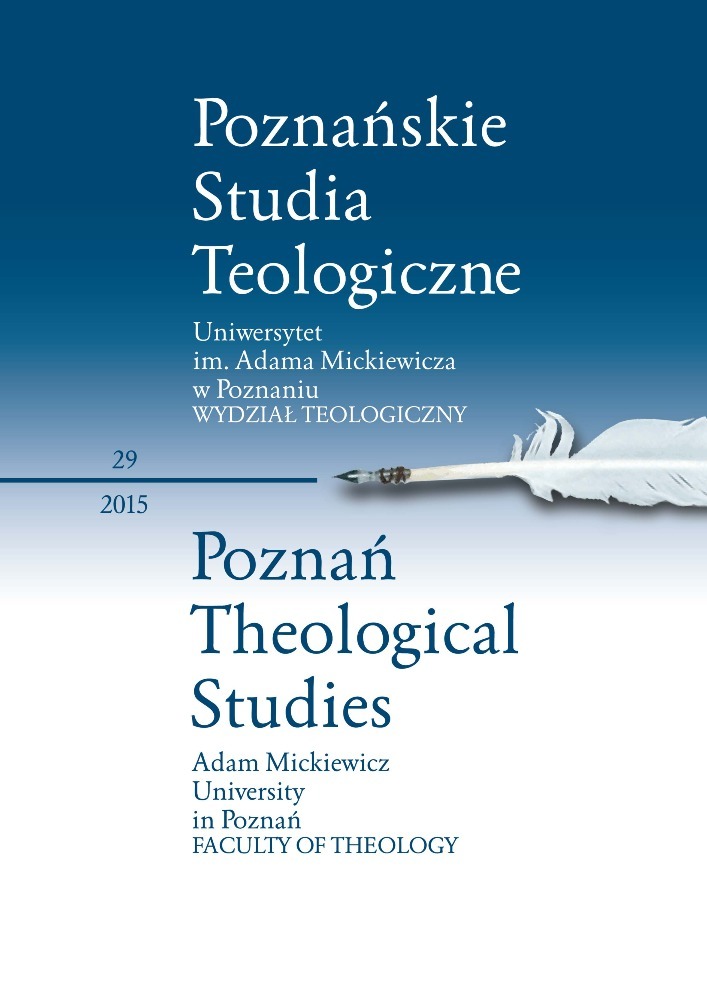Abstrakt
Apart from the two final states after death, heaven and hell, there is a third transitional state called “purgatory”. The Church believes in it, though this term does not occur in the Bible.
The aim of this paper is to present scriptural sites relating to purification after death. There are only a few texts that concern purgatory and in addition they do not point directly to it: 2 Macc 12:38-45 (prayers and atonement can help the dead), Matt 12:31-32 (certain offenses can be forgiven in the age to come) and 1 Cor 3:10-15 (there is a cleansing fire after death – different from the punishment of the damned). The message of these texts is clear: the lot of a man may be changed even after death.
One can also find in the Sacred Scripture some metaphors applying to purgatory: whipping (Lk 12:47-48), imprisonment for debts (Matt 5:25-26) and leaving the netherworld (Matt 12:4). Some scholars think, the Jesus’ parable of the rich man and Lazarus (Lk 16:19-31) also reveals the mystery of the final purification.
Although the Church believed in purgatory from the very beginning, she formulated her doctrine of faith on purgatory especially at the Councils of Florence (1439) and Trent (1547). What the Church teaches is that there is a purification that occurs after death for all who die in God’s friendship but who have not been sufficiently purified for the glory of heaven. The purification can involve some kind of pain or discomfort (poena damni – punishment of temporary rejection and poena sensus – punishment of the senses).
Martin Luther and the Protestants reject the doctrine of purgatory. They argue that if a man had to suffer in purgatory, the sacrifice of Jesus Christ would be incomplete and insufficient. The Catholic answer to the dilemma is that salvation assumes two steps: forgiveness of sins and transformation of life. The former occurs immediately, the latter needs time. God changes people and actually makes them righteous. Only when they are entirely sanctified and fully perfected, they are truly fit to enjoy the beatific vision of heaven. And what about people who die before they have been thoroughly transformed?
The Catechism of the Catholic Church (1032) encourages the faithful on earth to assist those being purified and to offer prayers, above all the Eucharistic sacrifice, almsgiving, indulgences, and works of penance undertaken on behalf of the dead.
Bibliografia
Anderson G., Is purgatory biblical? Beginning with David’s penitence. Gary A. Anderson shows the Scriptural structure of purgatory, „First Things” 217(2011), s. 39-44.
Atwell R., From Augustine to Gregory the Great. An evaluation of the emergence of the doctrine of purgatory, „Journal of Ecclesiastical History” 38(1987) 2, s. 173-86.
Basiuk M., Pismo Święte o czyśćcu, „Nasza Myśl” 10(2013) 37, s. 8-9.
Bietenhard H., Kennt das Neue Testament die Vorstellung vom Fegefeuer?, „Theologische Zeitschrift” 3(1947) 2, s. 101-22.
Boulding C., Purgatory. What do Catholics believe, „Epworth Review” 22(1995) 2, s. 101-109.
Brattston D., Hades, hell and purgatory in ante-Nicene Christianity, „Churchman” 108(1994) 1, s. 69-79.
Campbell J., Forgiveness in the age to come, (1-2), „Affirmation & Critique” 9(2004) 1, s. 56-69; 2, s. 78-95.
Casey J., After lives. A guide to heaven, hell, & purgatory, Oxford 2010.
Chrostowski W., Niebo, piekło i czyściec w perspektywie biblijnej, w: Niebo, piekło, czyściec. Spojrzenie Kościoła. Praca zbiorowa, red. K. Czapla, P. Góralczyk. Zakopane–Ząbki 2010, s. 27-54.
Granat W., Biblia oparciem nauki o czyśćcu, w: Ku człowiekowi i Bogu w Chrystusie. Zarys dogmatyki katolickiej, t. 2, Lublin 1974, s. 519-521.
Horne B., Where is purgatory, San Francisco 1988, s. 92-100.
Jugie M., Purgatory and the means to avoid it, Westminster, Md 1949.
Kałdon S., Czyściec jako przejaw Bożego miłosierdzia, „Ruch Biblijny i Liturgiczny” 53(2000) 3-4, s. 213-222.
Kaszowski M., Niebo, piekło, czyściec i to, co nastąpi na końcu. Synteza eschatologii, Katowice–Mikołów 2009.
Kijas Z., Niebo w domu Ojca, czyściec dla kogo, piekło w oddaleniu, Kraków 2010.
Kinast R., The pope, purgatory, and process theology, „Encounter” 73(2013) 3, s. 39-46.
Klinkowski J., Dlaczego modlimy się za zmarłych?, „Legnickie Wiadomości Diecezjalne” 20(2011) 3, s. 98-107.
Langemeyer G., Himmel, Hölle, Fegefeuer. Was erwartet der Christ nach dem Tod?, Freiburg 1990, s. 78-92.
Lanne E., The teaching of the Catholic Church on purgatory, „One in Christ” 28(1992) 1, s. 13-30.
McGuire B., Purgatory, the communion of saints, and medieval change, „Viator” 20(1989), s. 61-84.
Merkt A., Das Fegefeuer. Entstehung und Funktion einer Idee, Darmstadt 2005.
Ombres R., The doctrine of purgatory according to St Thomas Aquinas, „Downside Review” 99(1981) 337, s. 279-87.
Ombres R., The theology of purgatory, Dublin 1980.
Perry A., Purgatory. The logic of total transformation, „Wesleyan Theological Journal” 48(2013) 1, s. 205-07.
Porada R., Czyściec – dojrzewanie do chwały. Nauka o eschatologicznym stanie oczyszczenia w dialogu luterańsko-rzymskokatolickim w USA, w: Człowiek dialogu. Księga pamiątkowa dedykowana księdzu arcybiskupowi Alfonsowi Nossolowi z okazji 80. rocznicy urodzin, 55. rocznicy święceń kapłańskich oraz 35. rocznicy święceń biskupich, red. Z. Glaeser, Opole 2012, s. 587-605.
[Salij J.] js, Ogień czyśćcowy, „W Drodze” 19(1991) 11, s. 108-112.
Salkeld B., Can catholics and evangelicals agree about purgatory and last judgment?, New York 2011.
Stackhouse J., The hard work of holiness. Protestants and purgatory, „Christian Century” 131(2014) 12, s. 26-29.
Stępień J., Nauka św. Pawła o śmierci, „Ruch Biblijny i Liturgiczny” 15(1962) 5, s. 283-291.
Swanson R., The burdens of purgatory, w: Medieval Christianity, red. D. Bornstein, Minneapolis 2009, s. 353-380, 396-397.
Townsend J., 1 Corinthians 3:15 and the school of Shammai, „Harvard Theological Review” 61(1968) 3, s. 500-504.
Walls J., Purgatory. The Logic of Total Transformation, Oxford 2012.
Wronka S., Eschatologiczna kara w Łk 12,47-48a (nowotestamentowy argument na rzecz czyśćca?), „Zeszyty Naukowe Stowarzyszenia Biblistów Polskich” 2(2005), s. 263-290.
Licencja
Copyright
© 2015 Uniwersytet im. Adama Mickiewicza w Poznaniu, Wydawnictwo Naukowe UAM, Poznań
OPEN ACCESS
